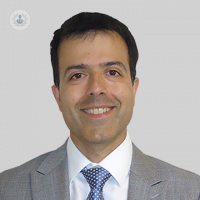Top 5 causes of a blocked nose
Escrito por:A blocked nose - also known as nasal obstruction - describes the sensation of reduced airflow either through one nostril or both. Prof Paul Chatrath, a distinguished consultant ear, nose and throat surgeon based in London and Essex, lists the top five causes of a blocked nose.

1. Swelling of the lining of the nose
The mucus membrane, or mucosa, is a thin moist lining that covers the bone and cartilage inside your nose. Sometimes, this lining can become inflamed as a result of many different problems:
- Allergic rhinitis — an allergy can cause the nasal lining to swell up. This leads to a blocked nose and additional symptoms such as itching, sneezing, excess mucus and a runny nose.
- Rhinitis medicamentosa — while decongestant nasal sprays can help unblock your nose for a few hours, if it some are overused for more than a few days they damage the lining of the nose and cause inflammation.
- Autonomic rhinitis — clear mucus production is the main problem with less nasal obstruction. It is caused by overactivity of the glands in the nose. It is not that common and typically occurs in people over 60.
- Infections — certain infections, especially from a virus, can cause a thick production of green mucus throughout the day.
- Idiopathic rhinitis — this is a group of nasal diseases where neither allergy nor infection can be found, however, the lining of the nose remains swollen.
2. Deviated nasal septum
Your septum is a thin piece of bone and cartilage in the middle of your nose. It separates the nasal cavity into two - the left and right side.
Most people’s septums are slightly bent or deviated to one side. This in itself does not always cause a feeling of a blocked or stuffy nose as there is usually enough space for air to pass through. If the septum is, however, significantly deviated, it can partially or fully block the air passage through the nose. This feeling is usually fixed to one side.
Treatment depends on how bad the nasal obstruction is and how it is affecting you. Surgery can correct deformities to both unblock and improve the appearance of your nose.
3. Nasal valve collapse
The nasal valve is located in the middle to lower part of the nose and its primary function is to limit airflow. When you breathe in through your nose, it is normal for there to be a small amount of collapse of the sides of the nostrils; however, if you have nasal valve collapse it can cause the already narrow airways to collapse entirely and block air from entering. It is usually caused by weakness or previous injury to the nose.
Treatment involves strengthening the sidewall of the nose, which can be achieved in several different ways:
Non-surgical:
- External nasal splint — a Breathe Right strip can be worn on the nose, particularly at night. This stops the walls of the nose from collapsing inwards.
- Nasal dilators — these are inserted inside the nostrils and can help some people in supporting the nasal sidewalls and preventing collapse.
Surgical:
- Cartilage augmentation — additional cartilage can be introduced to support the already weakened nasal cartilages. The surgery doesn’t always work as the additional cartilage can also weaken over time.
- Titanium implant — a recent development is the use of a titanium nasal implant. This is placed beneath the skin, over the upper lateral cartilages. It helps to prevent the weakened upper lateral from collapsing inwards when you breathe in. These implants are very new, however, the vast majority of patients who have undergone this treatment have reported outstanding results with very little complications.
- Intranasal z-plasty — this procedure doesn’t require any cartilage or implants and is undertaken entirely through the nose. It involves creating skin flaps inside the nose to widen and strengthen the nasal valve.
4. Adenoid enlargement
Adenoids are small lumps of tissue at the back of the nose and above the roof of the mouth. They are the most common cause of nasal obstruction in this area, particularly in young children. Enlarged adenoids can cause snoring and sleep apnoea at night, as well as contributing to the development of glue ear.
If a child only snores at night, it isn’t usually anything to be concerned about. However, if they also stop breathing while asleep - a condition known as sleep apnoea - then adenoidectomy with or without tonsillectomy might need to be considered.
Avoid the long-term use of over-the-counter nasal medication unless advised by your doctor or ENT surgeon. If in doubt contact your doctor.
5. Nasal polyps
Nasal polyps are semi-transparent growths that can form in any part of the internal lining of the nose. Nasal polyps contain inflammatory fluid and, while they can be associated with allergy and infection, the exact reason why some people get them and not others is not known.
Nasal polyps can occur in combination with other diseases, most commonly asthma, or can occur in patients with aspirin intolerance or cystic fibrosis.
While each polyp is relatively small, multiple polyps situated together can obstruct the inside of the nose. The commonest symptom that they cause is, therefore, a blocked nose, together with a reduced or even absent sense of smell. Other symptoms that may occur include a runny nose, sneezing and postnasal drip.
- Non-surgical treatment
The initial management of nasal polyps is either by taking topical sprays, drops or oral (tablet) preparations. The main form of treatment is with steroids, as these effectively reduce the inflammation. Intranasal steroid sprays can be taken for many years as very little is absorbed into the body, although they may take up to six weeks of continuous treatment before their full effect can be felt.
- Surgical treatment of nasal polyps
If the previous medical treatments aren’t successful, surgery to remove the nasal polyps can be undertaken. This nasal polypectomy procedure is typically combined with functional endoscopic sinus surgery (FESS) as the polyps tend to originate from the sinuses. Surgery is carried out under a general anaesthetic.
In some situations, the use of the minimally invasive balloon sinuplasty procedure can also be beneficial to help clear the sinuses.
Unfortunately, nasal polyps do tend to recur in the future, usually after a few years but could be longer. This is more likely to occur in patients with either asthma or aspirin sensitivity. Very occasionally they may recur sooner, especially in association with one of these conditions, however, most patients enjoy many years and even decades without problems.
If you are suffering from any of the symptoms mentioned in this article, book a consultation with Prof Paul Chatrath by going to his Top Doctors profile and checking his availability.


